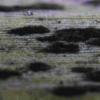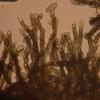
29-12-2025 17:01
Gernot FriebesHi,I'm looking for help with this hyphomycete with

29-12-2025 08:30
Hello.A tiny ascomycete sprouting under Juniperus

29-12-2025 10:15
Hulda Caroline HolteHello, I found and collected this propoloid ascom

29-12-2025 09:38
Oskari VirtanenHi,could anyone help me identify this, I suspect P

28-12-2025 12:08
Margot en Geert VullingsThis possible Karstenia was found on the bark of d

21-12-2025 21:32
Pol DebaenstHello, Garden, Burgweg 19, Veurne, BelgiumOn 10/1

26-12-2025 21:19
Arnold BüschlenPithyella chalaudii Priou. Ist als Bryoparasit in

21-12-2025 09:32
Hello.A tiny ascomycete found embedded in wood in

18-12-2025 21:17
Pol DebaenstThe identification took me to Byssonectria deformi
Densely Grouped Conidiophores on Phragmites
Peter Thompson,
21-11-2017 11:59
I have found a hyphomycete which grows densely clustered along the small ridges of a dead leaf of Phragmites australis.
The conidiophores are mid-brownish, knobbly, with scars along them and measuring between 68 - 130 x 5 um. They are smooth, regularly septate and thick walled.
The conidia are pale 1- 3-septate, with the largest being 16 - 18.5 x 7.25 - 8 um. Their bases are flattened, where previously attached to the conidiophores.
The closest species which I can find in the literature is Dendryphiella infuscans, but this species does not seem to grow in dense tufts, like mine.
I have attached a photo of the fruit bodies and also a microphoto, showing more detail of their structure.
I wonder if anyone has any ideas as to what they might be?
Thank You,
With Best Wishes,
Peter.
Chris Yeates,
21-11-2017 17:15

Re : Densely Grouped Conidiophores on Phragmites
It looks very like a species of Cladosporium, a very common and rather complex genus. See:
https://www.researchgate.net/publication/284233129_Common_but_different_The_expanding_realm_of_Cladosporium
https://www.researchgate.net/publication/284233129_Common_but_different_The_expanding_realm_of_Cladosporium
Peter Thompson,
21-11-2017 17:46
Re : Densely Grouped Conidiophores on Phragmites
Hello Chris,
Thanks. I will have a look through this paper.
I did consider the genus Cladosporium, but was not sure that they would grow so densely grouped as my sample.
With Best Wishes,
Peter.
Thanks. I will have a look through this paper.
I did consider the genus Cladosporium, but was not sure that they would grow so densely grouped as my sample.
With Best Wishes,
Peter.
Herrera Emerson,
21-11-2017 18:01
Re : Densely Grouped Conidiophores on Phragmites
Buen día, por el momento pense en Cladosporium pero esta produce esporas de una celula. Son irregulares pero no es Cladosporium.
Chris Yeates,
21-11-2017 18:16

Re : Densely Grouped Conidiophores on Phragmites
Does "esta produce esporas de una celula" mean "produces spores with a single cell"? Because Cladosporium conidia can have several septa - compare with:
http://www.discoverlife.org/20/q?search=Cladosporium+macrocarpum
Chris
http://www.discoverlife.org/20/q?search=Cladosporium+macrocarpum
Chris

